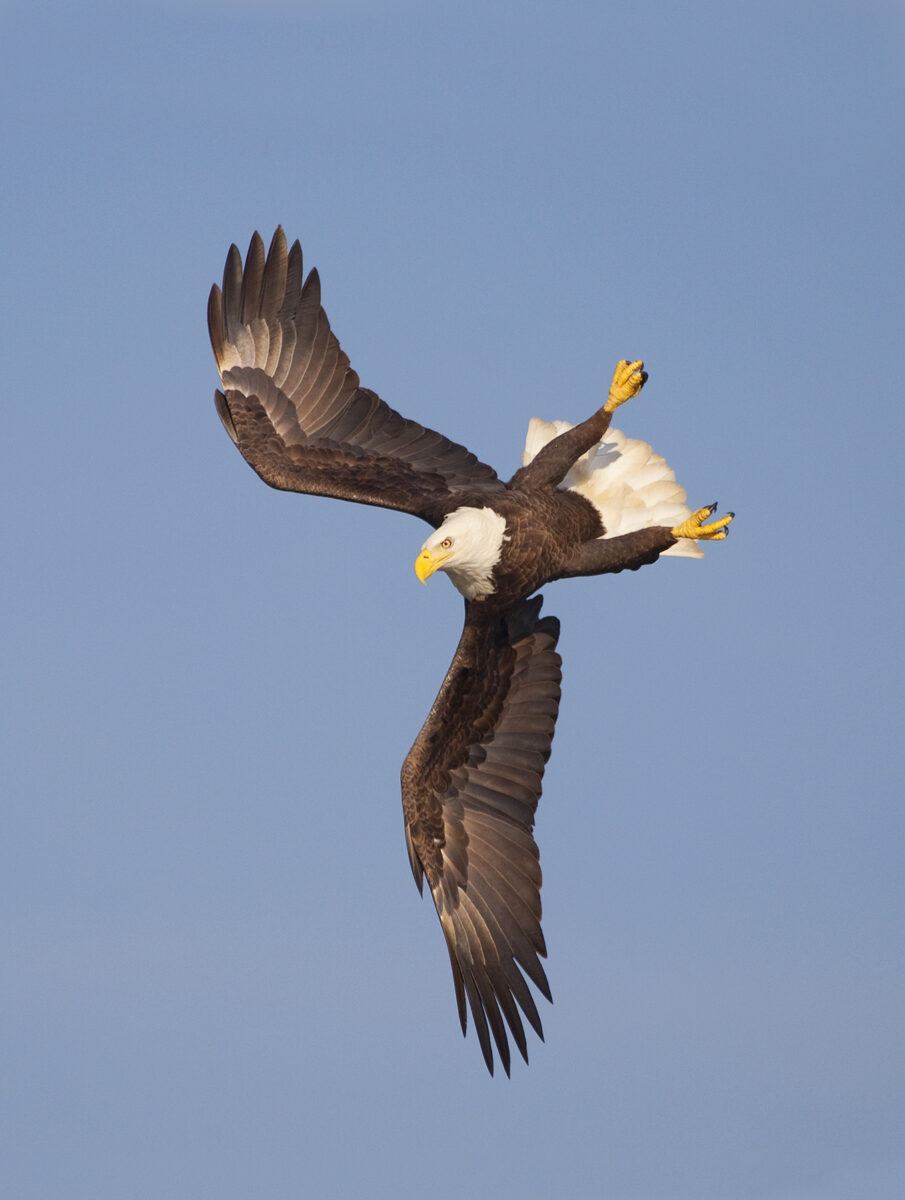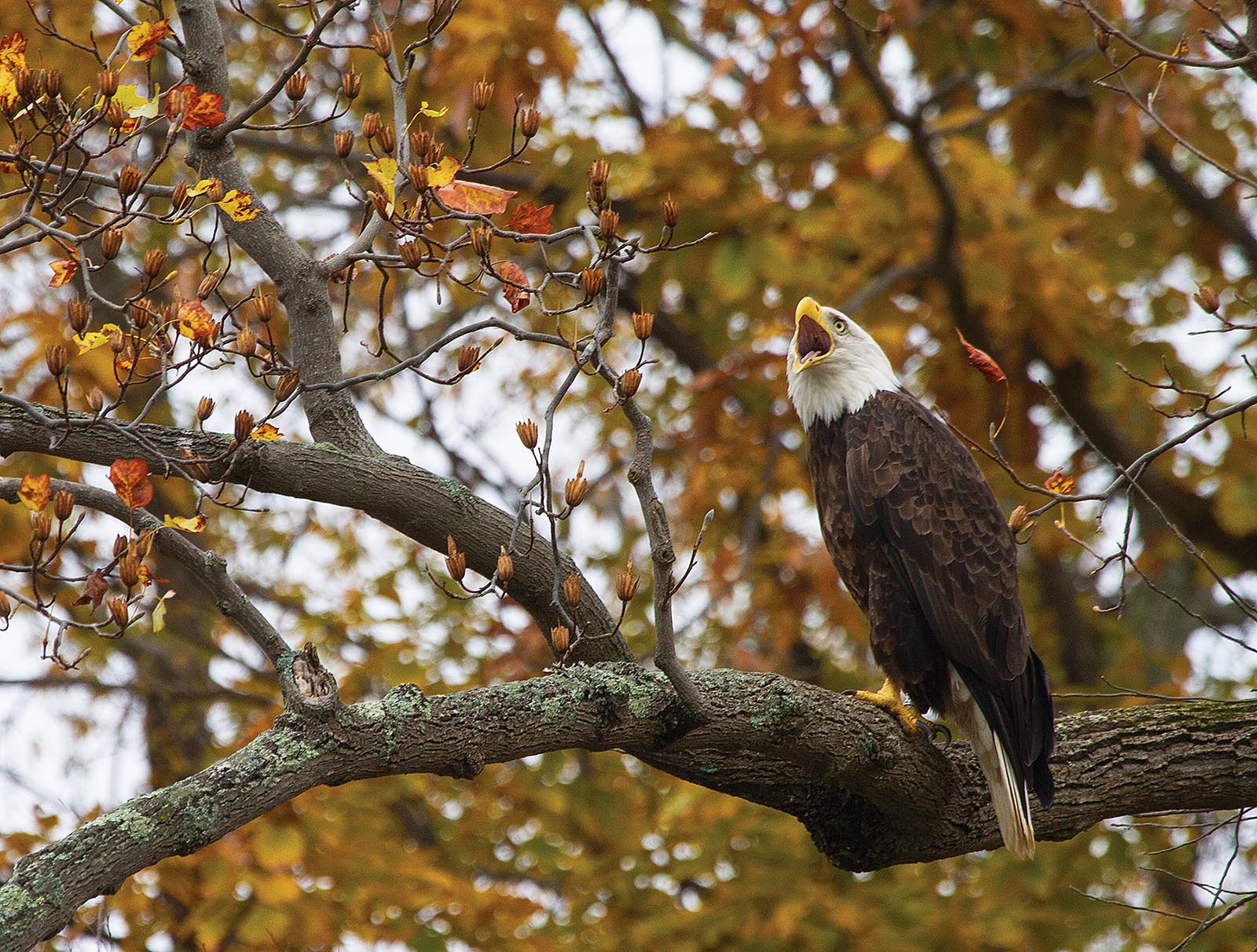By Molly Kirk/DWR
There’s no more iconic emblem of the impact of the Endangered Species Act (ESA) than the bald eagle. The national bird since 1782, this majestic species serves as a symbol not only of the country, but also of the success of endangered species protection. “I can’t really think of a greater wildlife management success story; it’s one of the biggest,” said Jeff Cooper, DWR’s nongame bird project coordinator.
When the ESA was enacted in 1973, bald eagle population numbers across the country showed that the species was close to disappearing. “The bird had very low abundance in the lower 48 states—there were only about 30 breeding pairs in Virginia when historically there were over 2,000 breeding pair in the state,” said Cooper. “The numbers dwindled down to nothing.”

Bald eagle populations in Virginia have rebounded in the last few decades. Photo by Lynda Richardson/DWR
Food source contamination by DDT (dichlorodiphenyltrichloroethane) insecticide was a major contributor to the bald eagle’s population decline, and a federal ban of DDT was essential to their conservation. But habitat destruction and degradation and illegal shooting had also negatively impacted the eagle population. The ESA provided habitat protection, allowing DWR to protect bald eagle nest sites in Virginia with restrictions in certain areas and at specific times of the year that prevented certain activities from occurring that would disturb eagles.
“The ESA listing also very much raised awareness of the bald eagle’s conservation. Shootings of eagles diminished over time, which probably had a lot to do with educating the public and the big fines associated with shooting an eagle,” said Cooper. The Bald and Golden Eagle Protection Act (16 U.S.C. 668-668d), enacted in 1940, prohibits anyone, without a permit issued by the Secretary of the Interior, from “taking” bald or golden eagles, including their parts (including feathers), nests, or eggs. Before the ESA, in the 1950s and ‘60s, eagles were shot routinely despite the protection. The ESA listing helped bring public attention to the issue.

A bald eagle. Photo by Lynda Richardson/DWR
Part of the work DWR did for bald eagles before and after the species’ ESA listing was extensive population surveys. “DWR and the Center for Conservation Biology at the College of William and Mary put a lot of work into documenting nests, roosts and concentration areas,” said Cooper, who started at DWR in the early 2000s. Keith Cline, his predecessor, had done the bulk of the conservation work for bald eagles in the decades prior. “The agency, along with the Center for Conservation Biology, did extensive nest surveys (by aircraft) and shoreline surveys over the years by boat, looking for concentration areas, which are areas with routinely elevated eagle abundance, particularly during mid-winter and mid-summer. We have some remarkable concentration areas in Virginia along our tidal rivers that are important not just to Chesapeake Bay birds, but also for birds from the Southeast and Northeast populations that converge on the Bay at different times of the year. The northern birds spend the winter here and the southern birds migrate north after their breeding season and spend the summer on our rivers. That’s due to the foraging opportunities they have here on the Bay and its tidal rivers.
“Through the early 1970s and into the early ‘80s, numbers increased gradually,” Cooper noted. “Then, as you got into the ‘90s, there was still gradual growth. From the late ‘90s into the 2000s, the population really exploded. There was a doubling rate of every several years or so for a while. We’re at the point now where we’re still seeing some increase, but that population growth has diminished a bit. We’re probably seeing saturation, at least in the eastern part of the state. We are seeing them in non-traditional habitat now, out in the Piedmont and the mountains.”

DWR worked on populations surveys and nest counts for bald eagles. Photo by Shutterstock
Those population data helped Virginia contribute to the de-listing process for the bald eagle. “There was a lot of review of data and U.S. Fish and Wildlife Service de-listing proposals and bald eagle management guidelines. We wrote numerous letters related to de-listing plans and population status with our opinion, as did all the other states,” said Cooper. “We helped to fund the Center for Conservation Biology’s 30-year nest data set to help with the determination. We also reviewed the post-de-listing monitoring plan, which had to be in place.” The decades of conservation work and protection had paid off; in 2007 the bald eagle was removed from the Federal Endangered and Threatened Species List. In 2013, the species was removed from the Virginia List of Endangered and Threatened Species.
While bald eagle populations are no longer considered endangered or threatened, and majestic individuals of the species can be spotted swooping over Virginia’s rivers frequently, the work to protect them continues. DWR continues to manage human-wildlife conflict involving bald eagles and has also been studying how to mitigate eagle airstrikes with civilian and military aircraft.
“It’s hard to bring something back from the brink like that. It’s the work of our predecessors that did all that,” said Cooper. “My generation of biologists were the tail end of it. Our agency has contributed tremendous resources, and still does, for eagle conservation over the years,” said Cooper. “Our administrators have always been good at supporting those projects, and we’ve had good buy-in from the public. A lot of the work we’ve done has been recognized nationally and by other states.”

